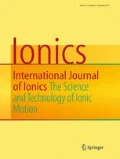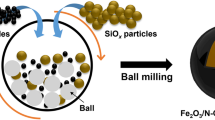Abstract
As a potential anode material for Li-ion batteries, ZnO has been intensively studied owing to its high theoretical capacity and low cost. However, low electronic conductivity restricted the application of ZnO in Li-ion batteries. It has been well recognized that morphology-controlled ZnO nanostructures can serve as high-performance anode materials. Here carbon-decorated flower-like ZnO nanostructures have been synthesized by microwave-assisted hydrothermal reactions. The carbon decoration on the flower-like ZnO surface not only suppresses the growth of ZnO crystals but also increases the electronic conductivity of ZnO. The results indicate that the nanocarbon-decorated flower-like ZnO materials can be employed as high-performance anode materials for advanced Li storage.





Similar content being viewed by others
References
Tang X, Chen H, Ding Y (2019) Mechanical properties of double-layered borophene with Li-storage. Mater Res Express 6(3):035010
Ding Y-H, Zhang P (2012) Effect of Mg and Co co-doping on electrochemical properties of LiFePO4. Trans Nonferrous Metals Soc China 22:s153–s156. https://doi.org/10.1016/S1003-6326(12)61701-4
Xiang HF, Li ZD, Xie K, Jiang JZ, Chen JJ, Lian PC, Wu JS, Yu Y, Wang HH (2012) Graphene sheets as anode materials for Li-ion batteries: preparation, structure, electrochemical properties and mechanism for lithium storage. RSC Adv 2(17):6792–6799. https://doi.org/10.1039/C2RA20549A
Lu P, Sun Y, Xiang H, Liang X, Yu Y (2018) 3D amorphous carbon with controlled porous and disordered structures as a high-rate anode material for sodium-ion batteries. Adv Energy Mater 8(8):1702434. https://doi.org/10.1002/aenm.201702434
Chen Y, Lu Z, Zhou L, Mai Y-W, Huang H (2012) Triple-coaxial electrospun amorphous carbon nanotubes with hollow graphitic carbon nanospheres for high-performance Li ion batteries. Energy Environ Sci 5(7):7898–7902. https://doi.org/10.1039/C2EE22085G
Li X, Chen Y, Huang H, Mai Y-W, Zhou L (2016) Electrospun carbon-based nanostructured electrodes for advanced energy storage – a review. Energy Storage Mater 5:58–92. https://doi.org/10.1016/j.ensm.2016.06.002
Li X, Fu N, Zou J, Zeng X, Chen Y, Zhou L, Lu W, Huang H (2017) Ultrafine cobalt sulfide nanoparticles encapsulated hierarchical N-doped carbon nanotubes for high-performance lithium storage. Electrochim Acta 225:137–142. https://doi.org/10.1016/j.electacta.2016.12.127
Chen H, Zhang W, Tang X-Q, Ding Y-H, Yin J-R, Jiang Y, Zhang P, Jin H (2018) First principles study of P-doped borophene as anode materials for lithium ion batteries. Appl Surf Sci 427:198–205. https://doi.org/10.1016/j.apsusc.2017.08.178
Gupta A, Dhakate SR, Gurunathan P, Ramesha K (2017) High rate capability and cyclic stability of hierarchically porous tin oxide (IV)–carbon nanofibers as anode in lithium ion batteries. Appl Nanosci 7(7):449–462. https://doi.org/10.1007/s13204-017-0577-8
Poizot P, Laruelle S, Grugeon S, Dupont L, Tarascon JM (2000) Nano-sized transition-metal oxides as negative-electrode materials for lithium-ion batteries. Nature 407:496. https://doi.org/10.1038/35035045
Yang Z, Ding Y, Jiang Y, Zhang P, Jin H (2018) Hierarchical C/SiOx/TiO2 ultrathin nanobelts as anode materials for advanced lithium ion batteries. Nanotechnology 29(40):405602
Ren HM, Ding YH, Chang FH, He X, Feng JQ, Wang CF, Jiang Y, Zhang P (2012) Flexible free-standing TiO2/graphene/PVdF films as anode materials for lithium-ion batteries. Appl Surf Sci 263:54–57. https://doi.org/10.1016/j.apsusc.2012.08.107
Lian P, Zhu X, Liang S, Li Z, Yang W, Wang H (2011) High reversible capacity of SnO2/graphene nanocomposite as an anode material for lithium-ion batteries. Electrochim Acta 56(12):4532–4539. https://doi.org/10.1016/j.electacta.2011.01.126
Zhao N, Wang G, Huang Y, Wang B, Yao B, Wu Y (2008) Preparation of nanowire arrays of amorphous carbon nanotube-coated single crystal SnO2. Chem Mater 20(8):2612–2614. https://doi.org/10.1021/cm703353y
Luo J, Liu J, Zeng Z, Ng CF, Ma L, Zhang H, Lin J, Shen Z, Fan HJ (2013) Three-dimensional graphene foam supported Fe3O4 lithium battery anodes with long cycle life and high rate capability. Nano Lett 13(12):6136–6143. https://doi.org/10.1021/nl403461n
Li F, Shangguan E, Li J, Li L, Yang J, Chang Z, Li Q, Yuan X-Z, Wang H (2015) Influence of annealing temperature on the structure and electrochemical performance of the Fe3O4 anode material for alkaline secondary batteries. Electrochim Acta 178:34–44. https://doi.org/10.1016/j.electacta.2015.07.106
Chae C, Kim KW, Yun YJ, Lee D, Moon J, Choi Y, Lee SS, Choi S, Jeong S (2016) Polyethylenimine-mediated electrostatic assembly of MnO2 nanorods on graphene oxides for use as anodes in lithium-ion batteries. ACS Appl Mater Interfaces 8(18):11499–11506. https://doi.org/10.1021/acsami.6b01931
Reddy MV, Subba Rao GV, Chowdari BVR (2013) Metal oxides and oxysalts as anode materials for Li ion batteries. Chem Rev 113(7):5364–5457. https://doi.org/10.1021/cr3001884
Xu G-L, Li Y, Ma T, Ren Y, Wang H-H, Wang L, Wen J, Miller D, Amine K, Chen Z (2015) PEDOT-PSS coated ZnO/C hierarchical porous nanorods as ultralong-life anode material for lithium ion batteries. Nano Energy 18:253–264. https://doi.org/10.1016/j.nanoen.2015.10.020
Quartarone E, Dall'Asta V, Resmini A, Tealdi C, Tredici IG, Tamburini UA, Mustarelli P (2016) Graphite-coated ZnO nanosheets as high-capacity, highly stable, and binder-free anodes for lithium-ion batteries. J Power Sources 320:314–321. https://doi.org/10.1016/j.jpowsour.2016.04.107
Li H, Wei Y, Zhang Y, Yin F, Zhang C, Wang G, Bakenov Z (2016) Synthesis and electrochemical investigation of highly dispersed ZnO nanoparticles as anode material for lithium-ion batteries. Ionics 22(8):1387–1393. https://doi.org/10.1007/s11581-016-1661-x
Xiao L, Mei D, Cao M, Qu D, Deng B (2015) Effects of structural patterns and degree of crystallinity on the performance of nanostructured ZnO as anode material for lithium-ion batteries. J Alloys Compd 627:455–462. https://doi.org/10.1016/j.jallcom.2014.11.195
Liu B, Zeng HC (2003) Hydrothermal synthesis of ZnO nanorods in the diameter regime of 50 nm. J Am Chem Soc 125(15):4430–4431. https://doi.org/10.1021/ja0299452
Shen GZ, Bando Y, Liu BD, Golberg D, Lee C-J (2006) Characterization and field-emission properties of vertically aligned ZnO nanonails and nanopencils fabricated by a modified thermal-evaporation process. Adv Funct Mater 16(3):410–416. https://doi.org/10.1002/adfm.200500571
Yan T, Lu CYJ, Schuber R, Chang L, Schaadt DM, Chou MMC, Ploog KH, Chiang CM (2015) Growth of c-plane ZnO on γ-LiAlO2 (100) substrate with a GaN buffer layer by plasma assisted molecular beam epitaxy. Appl Surf Sci 351:824–830. https://doi.org/10.1016/j.apsusc.2015.06.011
Ye Z, Wang T, Wu S, Ji X, Zhang Q (2017) Na-doped ZnO nanorods fabricated by chemical vapor deposition and their optoelectrical properties. J Alloys Compd 690:189–194. https://doi.org/10.1016/j.jallcom.2016.08.100
Han J, Liu Z, Guo K, Zhang X, Hong T, Wang B (2015) AgSbS2 modified ZnO nanotube arrays for photoelectrochemical water splitting. Appl Catal B Environ 179:61–68. https://doi.org/10.1016/j.apcatb.2015.05.008
Pung S-Y, Choy K-L, Hou X, Shan C (2008) Preferential growth of ZnO thin films by the atomic layer deposition technique. Nanotechnology 19(43):435609. https://doi.org/10.1088/0957-4484/19/43/435609
Kushima A, Liu XH, Zhu G, Wang ZL, Huang JY, Li J (2011) Leapfrog cracking and nanoamorphization of ZnO nanowires during in situ electrochemical lithiation. Nano Lett 11(11):4535–4541. https://doi.org/10.1021/nl201376j
Xie Q, Zhang X, Wu X, Wu H, Liu X, Yue G, Yang Y, Peng D-L (2014) Yolk-shell ZnO-C microspheres with enhanced electrochemical performance as anode material for lithium ion batteries. Electrochim Acta 125:659–665. https://doi.org/10.1016/j.electacta.2014.02.003
Cauda V, Pugliese D, Garino N, Sacco A, Bianco S, Bella F, Lamberti A, Gerbaldi C (2014) Multi-functional energy conversion and storage electrodes using flower-like zinc oxide nanostructures. Energy 65:639–646. https://doi.org/10.1016/j.energy.2013.12.025
Shen X, Mu D, Chen S, Wu B, Wu F (2013) Enhanced electrochemical performance of ZnO-loaded/porous carbon composite as anode materials for lithium ion batteries. ACS Appl Mater Interfaces 5(8):3118–3125. https://doi.org/10.1021/am400020n
Shi R, Yang P, Wang J, Zhang A, Zhu Y, Cao Y, Ma Q (2012) Growth of flower-like ZnO via surfactant-free hydrothermal synthesis on ITO substrate at low temperature. CrystEngComm 14(18):5996–6003. https://doi.org/10.1039/C2CE25606A
Feng J-J, Liao Q-C, Wang A-J, Chen J-R (2011) Mannite supported hydrothermal synthesis of hollow flower-like ZnO structures for photocatalytic applications. CrystEngComm 13(12):4202–4210. https://doi.org/10.1039/C1CE05090G
Raula M, Rashid MH, Paira TK, Dinda E, Mandal TK (2010) Ascorbate-assisted growth of hierarchical ZnO nanostructures: sphere, spindle, and flower and their catalytic properties. Langmuir 26(11):8769–8782. https://doi.org/10.1021/la904507q
Gao X, Li X, Yu W (2005) Flowerlike ZnO nanostructures via hexamethylenetetramine-assisted thermolysis of zinc−ethylenediamine complex. J Phys Chem B 109(3):1155–1161. https://doi.org/10.1021/jp046267s
Bayan S, Gogurla N, Midya A, Ray SK (2016) White light emission characteristics of two dimensional graphitic carbon nitride and ZnO nanorod hybrid heterojunctions. Carbon 108:335–342. https://doi.org/10.1016/j.carbon.2016.07.032
Zhang G, Hou S, Zhang H, Zeng W, Yan F, Li CC, Duan H (2015) High-performance and ultra-stable lithium-ion batteries based on MOF-derived ZnO@ZnO quantum dots/C core–shell nanorod arrays on a carbon cloth anode. Adv Mater 27(14):2400–2405. https://doi.org/10.1002/adma.201405222
Liu X, Sun Y, Yu M, Yin Y, Du B, Tang W, Jiang T, Yang B, Cao W, Ashfold MNR (2018) Enhanced ethanol sensing properties of ultrathin ZnO nanosheets decorated with CuO nanoparticles. Sensors Actuators B Chem 255:3384–3390. https://doi.org/10.1016/j.snb.2017.09.165
Augustyn V, Come J, Lowe MA, Kim JW, Taberna P-L, Tolbert SH, Abruña HD, Simon P, Dunn B (2013) High-rate electrochemical energy storage through Li+ intercalation pseudocapacitance. Nat Mater 12:518. https://doi.org/10.1038/nmat360140
Song X, Li J, Li Z, Xiao Q, Lei G, Hu Z, Ding Y, Kheimeh Sari HM, Li X (2019) Superior sodium storage of carbon-coated NaV6O15 nanotube cathode: pseudocapacitance versus intercalation. ACS Appl Mater Interfaces 11:10631–10641. https://doi.org/10.1021/acsami.8b20494
Acknowledgements
The financial support from the National Natural Science Foundation of China (No. 51002128), Scientific Research Foundation of Hunan Provincial Education Department (No.17A205), and Natural Science Foundation of Hunan Province (No. 2018JJ2393 and 2018JJ2394) is greatly acknowledged. Besides, Y.H.D sincerely appreciates the kind support from Mrs. Ding and brings her ‘ZnO’ flowers for the birthday.
Author information
Authors and Affiliations
Corresponding author
Ethics declarations
Conflict of interests
The authors declare that they have no competing interests.
Additional information
Publisher’s note
Springer Nature remains neutral with regard to jurisdictional claims in published maps and institutional affiliations.
Electronic supplementary material
ESM 1
(PDF 501 kb)
Rights and permissions
About this article
Cite this article
Ding, Y., Sun, J. & Liu, X. Carbon-decorated flower-like ZnO as high-performance anode materials for Li-ion batteries. Ionics 25, 4129–4136 (2019). https://doi.org/10.1007/s11581-019-02981-y
Received:
Revised:
Accepted:
Published:
Issue Date:
DOI: https://doi.org/10.1007/s11581-019-02981-y




